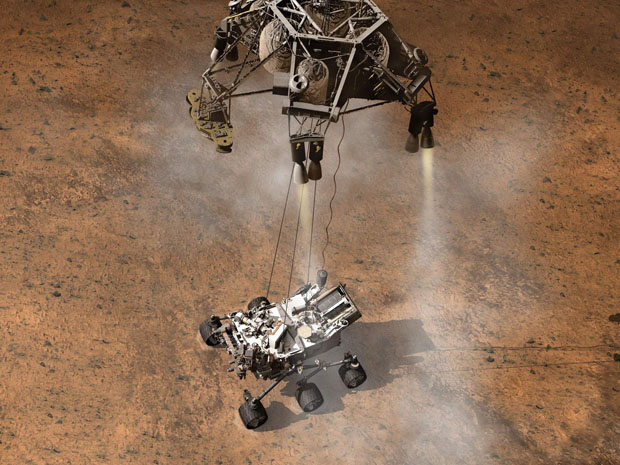It looked like it shouldn't work. It looked like it couldn't work. It looked like NASA's most talented engineers had got drunk together at a party and, for a dare, designed the most ridiculous, dangerous way of landing a multi billion dollar robot rover on Mars possible then giggled "Yeah, let's try that!" But early this morning, after screaming through the barely-there martian atmosphere in a fireball, the nuclear-powered "Curiosity" rover was lowered down from a hovering rocket platform and touched down softly and safely on the floor of the huge Gale crater.
The
first pictures - although hazy and blurred - suggest it came down
within a few kilometres of its goal: an ancient, layered mountain called
Mt Sharp which rises up from the crater's heart to scrape the pink
martian sky. Planetary scientists and armchair explorers alike are
delighted and impatient for Curiosity to begin rolling across the crater
floor and start exploring.
 |
| Artist's impression of Curiosity landing on Mars. Image: NASA/JPL-Caltech |
But what will Curiosity actually be doing on Mars? Well, a Google search of its name will bring up a lot of stories in the media about how the "Mars Science Laboratory" is going to look for life. It isn't. It's been sent to Mars to travel back in time and see if Mars, or at least this part of Mars, was once capable of supporting life.
But it won't travel back in time physically; it's not a TARDIS. It will journey into the red planet's past by studying the rocks, dirt and dust inside Gale crater, analysing their chemistry and mineralogy with spectroscopes, ovens, computers. It will zap rocks with a laser, and use instruments to analyse the gas which is produced, building up a detailed picture of their composition, learning about how they were formed and how they have changed over time. Reaching out with its powerful robot arm it will drill into rocks, collecting samples to drop into its own body, where they will be studied inside an incredibly powerful and sophisticated laboratory, taken apart to see exactly what they're made of.
And if it can navigate its way across the crater floor, and drive through or over a band of dark, wind-blown dust dunes that it can already see on the horizon, it will then start to climb, working its way slowly up through the rugged foothills of Mt Sharp, driving up an ancient valley, to a location on the mountain's side where its suite of incredible instruments will be able to study the gateau-like layers of rock there, laid down over millennia. Why? Because inside those layers it might find something... incredible. Not life itself, but traces of past life. Not the fossilised remains of ancient martian lifeforms, but the chemical "stains" of past life.
 |
| The first images sent back by Curiosity. Images: JPL/NASA |
Curiosity's scientists aren't expecting to see the fossils of flattened shells, ferns or bugs in the layers of Mt Sharp, but they are hoping to see lines, blips and spikes on graphs and charts betraying the presence of organics in the layers of rock and stone. If they find them, it could help answer the most nagging, most fundamental question in the whole of science: are we alone in the universe? Because if life once existed on Mars, even the most primitive form, then it suggests life on Earth wasn't just a fluke of nature, wasn't just the universe messing about with its chemistry set, but instead is a process than can be repeated where and when conditions are right. And that would suggest that life must exist "out there", elsewhere in the universe, right now.
But that's all for the future. Tonight, Curiosity is standing quietly, but proudly, on the surface of Mars, catching her breath and getting used to being out in the open again after being cocooned inside her heat shield and protective shell for almost 9 months. She won't begin to drive for a few days at least, not until her masters back on Earth have checked her out and given her a clean bill of health. But soon she will roll forwards on her giant, spiked wheels and begin to rove, cameras clicking, and one of the greatest quests in the history of exploration and discovery will begin in earnest.
I can't wait!
Stuart Atkinson
galegazette.wordpress.com
Stuart Atkinson is an amateur astronomer and Outreach Educator living in the UK. The author of a dozen children's books on astronomy and spaceflight, he writes the popular "Road to Endeavour" blog which chronicles the adventures of the Mars Exploration Rover "Opportunity" as it explores Endeavour Crater. A member of the unmannedspaceflight.com forum, he also writes "astropoetry" inspired by space missions and astronomy, and his work has been published on NASA websites.

No comments:
Post a Comment